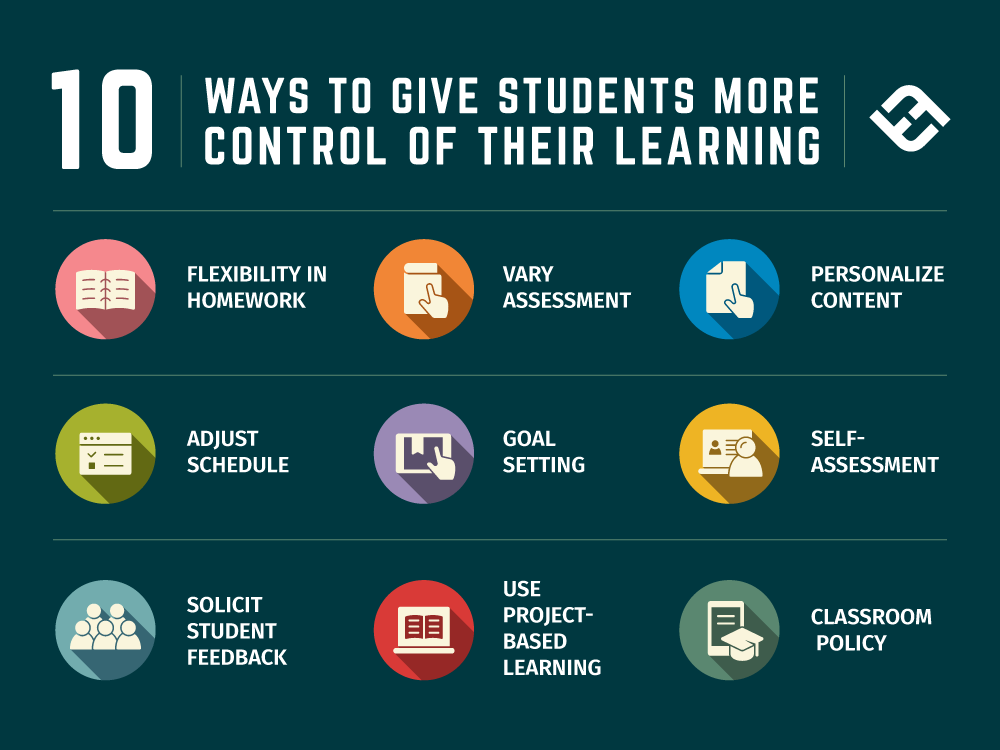
How To Give Students More Control Of Their Education
contributed by Jenna Smith
Allowing students to be involved and take control of their education gives them the tools to be much more successful.
As educators, the idea of giving students control can seem like a crazy move, but it actually gives them ownership in their learning. Relinquishing control in some areas of the classroom makes students more receptive to instruction, keeps them engaged in what they’re learning, and makes them more willing to take on challenges. So, how do you give students control without it turning into total chaos? Here are 10 areas you can safely give your students a little wiggle room to control their education.
10 Ways To Give Students More Control Of Their Education
1. Give them flexibility in homework
A common gripe among students is homework, but if you let them choose their assignment for the night, they will likely feel an enhanced sense of ownership because it was their decision. For example, give students a sheet of math problems, but let them choose the 10 they want to complete.
You can also let them choose different ways to study their spelling words or give them several options to dive deeper into a history subject. Giving students the choice for their assignment might not work for everything, but giving your students the occasional input can change their attitude toward homework altogether.
2. Measure understanding in different ways
More and more research is coming out that proves students shouldn’t be tested in one single, standardized way. Depending on the subject, write part of the test to include multiple-choice or fill-in questions, then give them the choice of two to three essay questions to choose from.
Varying the ways you test students could result in a better demonstration of their understanding since they’ll be able to communicate their retention in ways they’re most comfortable.
3. Personalize content and materials
Give students opportunities to choose their own books to read, science experiments to conduct, vocabulary lists to memorize, and math problems to solve. Online charter schools excel in this arena since students are allowed to pick from a plethora of course materials for each subject.
4. Let them create a schedule that works for them
This isn’t always practical, but allowing students to create their own schedule–and then revise it when they realize it is or isn’t working–can be a powerful way to add student ownership of their learning. Online schooling, for example, gives students the freedom to control their schedules because it allows them to decide when they want to complete each assignment.
Teachers at traditional schools can embrace this idea by allowing students to choose the order they’d like to do their tasks during class. Giving them this say puts them in control of their time, and they hopefully are less likely to waste it.
5. Help them set their own goals
At the start of each school year, ask students what they want to get out of the class. Some of their answers might be vague or even silly, but you might find that there are students who genuinely want to learn or better themselves in some way, like raising their GPA or getting into college. Allow them to set the standard for themselves for the year and let them know they’ll be held accountable.
See also How To Create Learning Through Play
6. Teach them to self-assess
Give students regular opportunities for self-evaluation. It can be at the end of the class period or the end of the week, but prompt them to reflect on their performance; this gives them responsibility for their own learning and keeps them accountable for how they’re using their time and progressing toward their goals.
7. Solicit feedback on your course or classroom
As teachers, we’re constantly evaluating students, but make sure you’re offering them the chance to give you feedback as well. Ask them to evaluate you, the course, or a specific assignment. This helps students feel heard and that they have a say in their learning.
8. Differentiate rubrics
Or have them make their own based on a universal one you create.
At the beginning of the school year, work with your students to establish clear grading criteria for projects. By allowing students to create their own rubric, they’re putting the onus on themselves to meet expectations for their work.
9. Use Project-Based Learning
Project-based learning is an excellent option for many classrooms.
Let students come up with their own ideas for project-based learning and track their own progress. Again, having a rubric in place before projects begin puts the responsibility on them to meet expectations. It can set a grading standard so that regardless of what students are creating—a website, essay, presentation, etc.—they’re able to express their creativity, take ownership of their learning experience, and set guidelines for what should be delivered.
10. Use supportive classroom policies
Involve students in decisions about classroom rules and policies. Giving them a voice in this arena strengthens their civic values, boosts academic achievement, and improves their engagement. It holds them responsible for their actions in the classroom and sets them up to own the consequences if they break a rule.
Putting students in control can feel like a gamble at first, but the payoff exceeds the risk in the long run.
Follow TeachThought on Facebook and let us know what benefits you’ve found in empowering your students in their education decisions.
